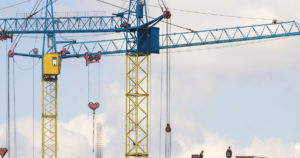Workplace Hazard: Cranes
October 20, 2020 Just a few weeks ago, 22 workers on a construction jobsite sustained injuries when two cranes collided. Medical personnel transported at least 16 people to the hospital for non-life-threatening injuries after the catastrophic incident, which everyone was lucky to survive. This recent accident serves as a sobering example of how hazardous it is to work on or around cranes. To limit preventable injuries, every employer needs to take precautions and protect workers through useful safety and health programs.
Just a few weeks ago, 22 workers on a construction jobsite sustained injuries when two cranes collided. Medical personnel transported at least 16 people to the hospital for non-life-threatening injuries after the catastrophic incident, which everyone was lucky to survive. This recent accident serves as a sobering example of how hazardous it is to work on or around cranes. To limit preventable injuries, every employer needs to take precautions and protect workers through useful safety and health programs.
Overhead cranes are frequently used in industrial settings to move or lift extremely heavy or bulky loads. Along with their impressive capabilities come major hazards, such as falling materials, insufficient inspection and maintenance schedules, and excessive load bearing. Certain industries have higher rates of crane-related injuries, like private construction, manufacturing, transportation, and extraction. According to the U.S. Bureau of Labor Statistics (BLS), 40-50 workers die in crane accidents every year. Cranes can also pose risks for the general public when they are used in urban or other densely populated areas.
Risk Factors for Accidents
In order to operate a crane, individuals are supposed to undergo rigorous training and meet certain knowledge and performance qualifications. But in some cases, employers cut corners to save in spending and to get a job done quickly, endangering everyone on and around the worksite. Excessive load bearing is another big concern. OSHA estimates that 80% of crane accidents result from exceeding posted load capacities. Not only can excessive loads lead to the crane dropping or swinging the load itself, but they can also cause structural damage to the machinery or even complete crane failure.
Another contributing factor to crane accidents is insufficient inspection and machine maintenance. OSHA mandates inspections on all new and altered cranes, and per the Crane Manufacturer’s Association of American (CMAA) guidelines, overhead crane inspectors must meet certain requirements. They are:
- A minimum of 2,000 hours of experience inspecting, maintaining, repairing, and testing cranes as well as all accompanying hoist equipment
- Understanding how to properly report and document inspection and maintenance protocols
- Knowledge of safety and design standards. Operators should also know their local, state, and federal codes for safe operating practices
Insufficient training, inspection, and maintenance all increase the likelihood of a serious crane accident happening. Workers who are not trained to operate or inspect cranes but who still work in close proximity to them face hazards associated with falling materials. Incidents involving falling materials happen for a variety of reasons like mechanical failures, having an untrained machine operator, ill-timed movement of materials, visual obstructions, and improper rigging and/or handling of the materials. Regardless what the cause behind a crane accident is, it can always lead to serious or deadly injuries for workers and bystanders alike.
Filing a Legal Claim for Crane Accident Injuries
When a crane accident results in injury, more than one party may be responsible. For example, crane manufacturers must adhere to certain safety and production standards to ensure their machines are safe to use. Crane companies that rent out equipment, acting as subcontractors and sometimes even providing operators have to abide by industry-wide standards. In some cases, contractors or developers who run their own cranes are negligent with training or supervision. Determining which party is responsible can be a complicated process. Sometimes, more than one party is responsible for a worker’s preventable injuries.
Luckily, here at Galfand Berger we have a team of experienced construction accident attorneys who can help you file a legal claim. If you were injured in a crane accident and would like to learn more, contact a representative online now.
Philadelphia Personal Injury Lawyers at Galfand Berger, LLP Representing Injured Workers Since 1947
Galfand Berger has offices located in Philadelphia, Bethlehem, Lancaster, and Reading, we serve clients throughout Pennsylvania and New Jersey. To schedule a consultation, call us at 800-222-8792 or complete our online contact form.
 Google Screened
Google Screened
